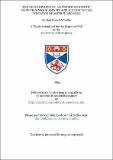Files in this item
The development of an improved kinetic flow technique and its application to the pyrolysis of methyl bromide
Item metadata
| dc.contributor.advisor | Horrex, Charles | |
| dc.contributor.author | Woolley, Gordon Robert | |
| dc.coverage.spatial | 146 p. | en_US |
| dc.date.accessioned | 2018-07-02T11:32:16Z | |
| dc.date.available | 2018-07-02T11:32:16Z | |
| dc.date.issued | 1965 | |
| dc.identifier.uri | https://hdl.handle.net/10023/14802 | |
| dc.description.abstract | The first object of this work was to produce a technique of analysing continuously the exit gases of flow reactors under conditions where the extent of decomposition is small, and to do this with particular reference to the small changes in reactant concentration. This was preferred to analysis for products since the translation of the data for the latter into kinetic rate equations requires a knowledge or assumptions of the stoichiometry. The second aim of the work was to apply the technique to typical systems as used for bond dissociation energy determinations and test the method on a reaction of importance. 2, Details have been given of the development of the system where the analyses can be performed mass spectrometrically and continuously on both the inlet and exit gases, with about 30 seconds between each sampling. The technique minimises the chance that variations in flow conditions or changes in reactor efficiency will pass undetected, it permits also variations in kinetic parameters to be studied without opening up the reactor but merely by altering the variables and waiting for new steady state conditions. In order to deal with the small variations in the large signals given by the reactant decomposition, an electrical backing off device was used after sufficient stability had been obtained. The details of this have been given. 3. In order to check the flexibility of the technique, the thermal decomposition of methyl bromide in excess toluene, previously investigated by Szwarc, was carried out in the flow system. 4. It was shown experimentally that the rate of decomposition of the methyl bromide was given by: -d [MeBr]/dt = {k₀ + k[sub]T[Toluene] + K[sub]A[Argon]} [MeBr] when using up to 0.1 mm CH₃Er in about 1 mm of toluene and 1 mm of argon carrier gas. The reaction was shown to be surface dependent and was studied in two furnaces of different S/V ratio. 5. Methods of analysis of the data have yielded k₀, k[sub]T and k[sub]A. The temperature coefficient of k₀ has been shown to be k₀ = 10 ¹¹·⁸⁶ exp (-66,700/RT) sec ⁻¹ in the range 960° 1090° . The activation energy from the K[sub]T temperature variation is 63.2 k.cals/mole. 6. The kinetic data-have been discussed and k₀ is ascribed to the first order decomposition process while the second term has been considered to be a surface reaction. The snail increase of the rate with rise in argon pressure is thought to be caused by increases in the steady state concentration of hydrogen atoms, due to argon impeding the partial wall removal of this entity, 7. The activation energy of 66,7 k.cals/mole for the unimolecular decomposition has been compared with other data on D(CH₃ - Br). 8. Finally, suggestions have been made for further work in the study of this reaction to aid a more complete understanding of the apparently complex mechanism involved. | en_US |
| dc.language.iso | en | en_US |
| dc.publisher | University of St Andrews | |
| dc.subject.lcc | QD258.W7 | |
| dc.subject.lcsh | Chemistry, organic | en |
| dc.title | The development of an improved kinetic flow technique and its application to the pyrolysis of methyl bromide | en_US |
| dc.type | Thesis | en_US |
| dc.contributor.sponsor | Carnegie Trust for the Universities of Scotland | en_US |
| dc.type.qualificationlevel | Doctoral | en_US |
| dc.type.qualificationname | PhD Doctor of Philosophy | en_US |
| dc.publisher.institution | The University of St Andrews | en_US |
This item appears in the following Collection(s)
Items in the St Andrews Research Repository are protected by copyright, with all rights reserved, unless otherwise indicated.

